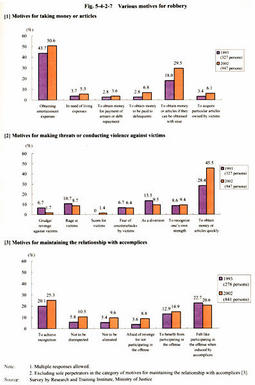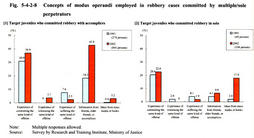| Previous Next Index Image Index Year Selection | |
|
|
2 Analysis of motives/concepts of modus operandi Robbery is the offense of taking the property of another by committing assault or extortion. In robbery cases committed by juveniles, not only did they have an intention of taking money or articles but also they had a motivation to conduct violence against victims. Some juveniles took money or articles from victims on the occasion of conducting violence to them or participated in robbery not only for the purpose of taking money or articles but also with the intention of maintaining a good relationship with accomplices. Thus, the matters of principal concern that the perpetrators had at the scene of the offense (hereinafter referred to as "matters of principal concern") are not limited to merely taking money or articles. We often find juveniles who committed robbery without particular intention but were led along due to the atmosphere at the scene of the crime and therefore cannot explain their reason for committing the offense.
Fig. 5-4-2-6 shows the comparison between the target juveniles of 1993 and the target juveniles of 2002 with respect to the matters of principal concern-"taking money or articles," "making threats or conducting violence against victims," "maintaining relationship with accomplices," and "no particular motivation." The number of juveniles whose matters of principal concern was "making threats or conducting violence against victims" is larger but the percentage of such juveniles is smaller among the target juveniles of 2002 than among the target juveniles of 1993. On the other hand, the percentage of juveniles whose matters of principal concern was "taking money or articles" is larger among the target juveniles of 2002 than among the target juveniles of 1993 and the number of such juveniles among the target juveniles of 2002 was 3.6 times larger than that among the target juveniles of 1993. These results imply an increase in the number of juveniles who have committed robbery with the matters of principal concern of taking money or articles. Fig. 5-4-2-6 Matters of principal concern at the time of the offense Among those who committed robbery with the matters of principal concern of taking money or articles, they had various motives for taking money or articles. Furthermore, some of them committed robbery with a combination of motives for taking money or articles and other motives for making threats or conducting violence against victims or motives for maintaining the relationship with accomplices. For these reasons, it is necessary to examine motives from various perspectives.Fig. 5-4-2-7 shows the results of the multiple responses to the question concerning motives. In the category of motives for taking money or articles, the percentage of "obtaining entertainment expenses" was the largest, followed by "obtaining money or articles if they can be obtained with ease." Both the percentage and number of the target juveniles who chose these two options has increased from 1993 to 2002. This suggests that juveniles do not always take money or articles based on an urgent need to obtain living expenses or repay debts. In the category of motives for making threats or conducting violence against victims, the percentage of "taking money or articles quickly" is the largest, and both the number and percentage of the target juveniles who chose this option has increased from 1993 to 2002. They conducted violence without careful consideration for the purpose of taking money or articles quickly, which resulted in robbery cases instead of larceny cases. This seems to be one of the causes of the recent increase in robbery cases. In the category of motives for maintaining the relationship with accomplices, the percentages of "to achieve recognition" and "felt like participating in the offense when induced by accomplices" are large. >From 1993 to 2002, both the percentages and numbers of "not to be disrespected," "not to be alienated," and "afraid of the revenge for not participating in the offense" has increased. This suggests distorted sense of human relationships among juvenile robbery offenders, i.e. they conduct violence for the purpose of taking money or articles while giving consideration to the relationship with accomplices. Fig. 5-4-2-7 Various motives for robbery Fig. 5-4-2-8 shows the sources of concepts of modus operandi employed in robbery cases committed by multiple perpetrators and those by sole perpetrators. Common sources of concepts among the target juveniles who committed robbery with accomplices were "information from friends, elder friends, or accomplices" and "experience of committing the same kind of offense." In particular, from 1993 to 2002, the percentage of "information from friends" has risen sharply and the number has increased more than 7 times. This indicates that robbery has recently become a topic among juveniles, and some of them not only talk about it but actually commit it. Among the target juveniles who committed robbery in solo, common sources of concepts were "experience of committing the same kind of offense" and "ideas from the mass media or books." In particular, from 1993 to 2002 both the percentage and number of robberies committed from "ideas from the mass media or books" has increased. This suggests that in recent years, more juveniles have committed robbery while obtaining ideas of modus operandi from the mass media or books. We cannot help but fear that robbery has become a familiar topic as it comes up in conversation between friends or in the mass media and because of this, the recognition that robbery is a heinous offense has weakened among juveniles who rather recognize this offense as an easy means to satisfy their various needs.Fig. 5-4-2-8 Concepts of modus operandi employed in robbery cases committed by multiple/sole perpetrators |


